25 Unusual aircraft
 Bashny.Net
Bashny.Net
001 Stipa-Caproni, barrel-shaped experimental aircraft (1932).
In the early 30's the engineer Luigi Steep served in the Italian Air Force proposed the original idea with the fuselage-pipe to increase the efficiency of the screw. This concept has received the name «Ala a turbina». Became interested in the ideas of the Italian Air Ministry ordered Stipe build a flying demonstrator. It was decided to build the aircraft factory of the company Caproni. First flight Stipa, equipped DeHavilland Gipsy III engine 120 hp, held October 7, 1932. Already during the tests the aircraft been crafted - increased elevators and construction of the tail. At the end of testing the aircraft was transferred to the Research Center Montecelio, where he received a registration number MM.187. The aircraft successfully completed these tests, but the results did not satisfy the military, and in 1933 it was dismantled.
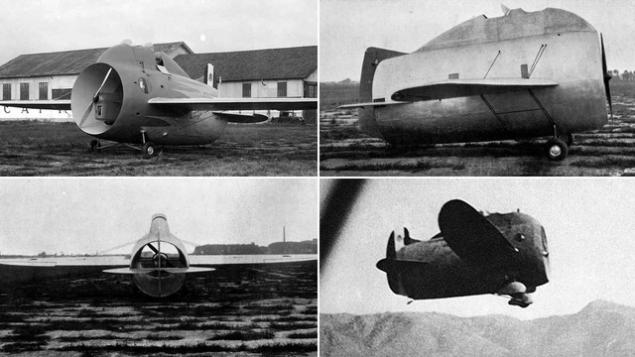
002 Vought V-173 "Flying Pancake" American fighter pilot for the US Navy (1942).
In the 1940s, American engineer Charles Zimmerman has created a unique aircraft aerodynamic configuration, which still continues to surprise not only for its unusual appearance, but the flight characteristics. For its unique appearance, he received numerous nicknames, among them such as "Flying parachute", "Flying Pancake" and "Skimmer Zimmerman." Who can say with certainty that the aircraft along with Fi-156 - one of the first devices vertical / short takeoff and landing.
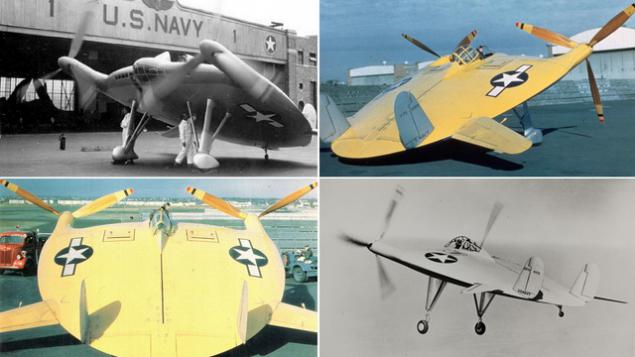
003 Blohm & Voss BV 141, German tactical reconnaissance aircraft differs unusual asymmetry.
In 1937, Reich Air Ministry issued a requirement for a new reconnaissance aircraft. The main requirement was to ensure a good view from the cockpit. Contractor should be firm "Arado" but "Focke-Wulf" and "Blomm + Voss" offered their development. "Focke-Wulf" project proposed twin-engine reconnaissance «Fw 189". "Blomm + Voss" offered more than the original version of the aircraft with an asymmetrical arrangement of the cab and the horizontal tail docked, which improves visibility.
Made of Plexiglas gondola crew resembling a gondola "Focke-Wulf Fw 189", located on the right. On the left is a cylindrical fuselage, which housed the engine «Bramo 323". The fuselage tail ended in that on the first prototypes were symmetrical. In the later samples of the tail unit was shifted to the left to provide a larger field of view arrow.
It seems that the asymmetric design dangerous disbalansiruet plane. However, flight tests confirmed the excellent stability and maneuverability. In addition, increased weight on the right side of the aircraft jet engine torque compensated.
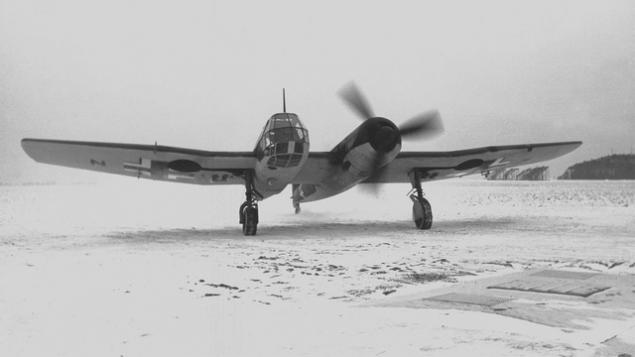
004 Douglas XB-42 Mixmaster, a bomber pilot, designed to bombard at high speed (1944).
In 1943. Douglas staff of the company in Santa Monica proposed conceptual design of the US Air Force medium bomber, pleasing almost optimal combination of classic features and novelty items. It was a plane with two engines placed in the fuselage and rotated by long coaxial shafts screws located in the rear fuselage. Under the engine bay was long and very capacious bomb bay. Cruciform tail served as a good protection for the propeller during takeoff and landing. The crew - three people: two pilots and navigator-bombardier.
It seemed that the idea devoid of serious shortcomings. Even at the stage of preliminary design was well thought through all the technical solutions that were to be put into this project. Equipped with a liquid-cooled in-line engines, "Allison» V-1710-125 capacity to 1725 liters. c., arranged in tandem, the aircraft had to lift up to 3,600 kg of bombs - as much as carrying the first "Flying Fortress" B-17A. Moreover, due to the large and long bomb bay, the new machine could take on board the British 1800 kg and 3600 kg bombs increased power. Maximum speed was estimated at 690-700 km / h - for 1943 is a fantastic figure. This incredible speed for a medium bomber was achieved by maximizing licking the fuselage, refining its aerodynamics and, mainly, through the use of laminar wing. Estimated range exceeded the range of the B-17, the latest series.
It should be noted that the structure of the aircraft was not provided any fundamentally new in the 1943 materials and technologies, the development of which could delay the transfer of a series of machines. The trouble was another - building, debugging and testing of aircraft required too much time, and that was, in the end, this sentence brainchild firm Douglas.
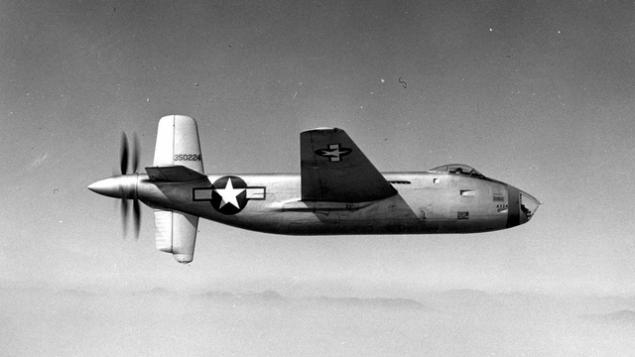
005 British Libellula, tandem wings, a twin-engine layout, created for the carriers (1945).
During the Second World War played an important role the use of naval aviation. The British carrier-based fighter "Hurricane Sea" and "Sifayr", being only slightly modified versions of overland aircraft, had large landing speed. To omit these planes in the hangar deck of aircraft carriers, it was necessary to make folding the wings, leading to an increase in take-off weight. To eliminate these drawbacks English constructor D. Miles developed a project based fighter scheme "tandem". The area of the front wing was 60% of the back. Due to the use of said arrangement intended to reduce the size of the wings, which allowed them to do non-folding, and simultaneously deflected down flaps on the front and back surfaces of the carrier were to provide low speed landing. To test this idea in the aviation company, led by Miles, it was built experimental aircraft M.35.Pervonachalno George Maylzplaniroval plane called Dragonfly, but takkak this name has already been used usamoleta de Havilland DH.90 was decided datproektu name Libellula. The layout of the aircraft M.35 was conceived as suitable for carrier-based fighter; the pilot had a maximum front-mounted, and the engine with a pusher propeller was installed behind the rear wing. As the lift provided two wings, the scope of which could be reduced, it was not necessary in their folding. M.35 aircraft was a single solid wood monoplane with a pusher propeller. The front bearing surface elevators are arranged at the rear - ailerons. Moreover, both surfaces have landing flaps. Vertical tail was carried out in the form of washers on the end of the wing. An interesting feature of the aircraft was a highly swept main wing endings. Swept wing helped to improve directional stability and damping longitudinal vibrations, allowing to increase the vertical stabilizer arm action. A three-wheeled chassis with nose wheel was provided with an additional rear wheel, which prevents the propeller from damage during landing with a large angle of attack. Making M.35 was entrusted company Phillips & Powis Aircraft Limited. The first prototype aircraft M.35 (under the temporary registration number U-0235) was made and raised in the air for six weeks (the first flight took place on May 1, 1942) .Real M.35 was not a real fighter, but rather a technology demonstrator and He did not even established any weapons. The tests revealed a significant aircraft longitudinal instability. Subsequently, by changing the alignment of several managed to improve the stability of the aircraft., But considering all the disadvantages, as well as taking into account the fact that the fighters who are in the time in service of the British Navy surpassed all indicators M.35 contract for production and has not been signed .
Despite the failure with the aircraft M.35, Miles did not leave his ideas and in 1942 proposed a draft twin-engine bomber near M.39 configuration. In the summer of 1943 it was built the plane M-39B, which is five times smaller prototype bomber. Unlike M.35 This aircraft had a smaller area of the front horizontal surface. Under the main wing was installed two engines, rotating pulling propellers. The machine took off July 22, 1943. Flying aircraft M-39B showed quite satisfactory stability and controllability of the aircraft in a wide range of CG. Like its predecessor, the M-39B aircraft had flaps on both wings with which it was possible to balance the plane at any position knob. The test aircraft were accompanied by a number of embarrassing setbacks. In one of the flight the pilot forgot to release the landing gear. Soon, during taxiing aircraft heavy small M-39B was overturned jet from the propeller and received significant damage. This test was completed on the project and the aircraft was given up.
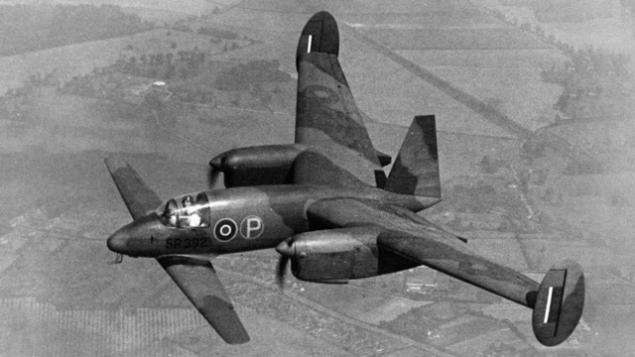
006 North American XF-82. In fact, it is "glued" together two P-51 Mustang, and we've got a fighter escort to long range (1946).
North American F-82 "Twin Mustang" (eng. North American F-82 Twin Mustang) - US long-range fighter double. Known as the last piston fighter of the US Air Force.
"Twin Mustang" was originally intended to escort strategic bombers B-29s during raids on Japan. In the course of these long-range raid fighter pilots were subjected to a heavy load, so the new fighter was to be a two-seater. North American company began designing this aircraft under the designation NA-120 in late 1943. It made an unusual design solution: the aircraft consisted of two elongated fuselage of fighter P-51H, connected by a wing and tailplane.
XP-82 prototype first flew on July 6, 1945 - too late to take part in World War II. This led to the fact that the initial US Air Force order for 500 aircraft was reduced by the end of 1945 to 270 aircraft. "Twin Mustangs" were replaced by P-61 "Black Uidou" as the main night fighter. They also brought to the task for which you were created - escort strategic bombers, the B-29, B-50 and B-36.
In February 1947, the P-82B (serial number 44-65168, "Betty Jo") made a nonstop flight from Honolulu to New York (about 5,000 miles), which took 14 hours and 32 minutes. Robert Tucker piloted aircraft and John Ard. This distance record for a piston fighter is not beaten yet. "Betty Jo" is the exposition of the National Museum of the US Air Force.

007 Northrop XB-35 heavy bomber pilot-wing developed for the US Army immediately after World War II.
In September 1941, the company «Northrop» began designing the giant aircraft - "flying wing" with four radial engines air cooling «Pratt & Whitney» R-4360-17 capacity of 3000 hp designed for the delivery of 10,000 pounds (4,540 kg) of bombs on a fantastic range of 5,500 km. Design Ferry range this combat load was 12,400 km. Before the engineering team of John Northrop fell a number of engineering, layout and aerodynamic problems that the process of research and development was delayed until the end of 1945 and the first prototype XB-35 Northrop made its first flight only June 25, 1946.
The plane hit the giant size and power - wingspan Northrop XB-35 was 52, 5 m. It was aerodynamically pure flying wing with a thick symmetrical profile. The layout of the car was quite dense and highly efficient - the benefits of the chosen scheme implemented to the maximum. Structurally, the body-wing Northrop XB-35 consisted of the central section (center section) and two consoles. The wear of the central section of the aircraft was equipped with a spacious and comfortable cabin sealed for six crew members. The commander of the crew, he also left the pilot, was placed on a hill and has all-round visibility thanks to the large drop-shaped lamp offset from the plane of symmetry of the aircraft to the left. The second pilot was located to the right of and below the first. Before him there was a transparent panel windshield, let us a good overview forward and down.
The navigator-bombardier to the right of the second pilot. Over his workplace had Astrodome. Behind the commander of the crew sat gunner operator barbettes wing machine guns. His main working tool was a sighting periscope whose optical head out on top and on the bottom surface of the body - the wing. In the left rear of the cab radio operator located on the right - the flight engineer with a big dash of control engines. Between jobs radio operator and engineer I had a door leading to the cabin rear gunner in charge of the top, bottom and rear of the turret. The walls of the corridor leading to the back of the cabin, there were passages in the engine compartment for inspection and repair of engines in flight, equipped with air locks. In the case of flight sverhdlitelnyh in the center section there is adequate space to accommodate suspended beds for relief crew.
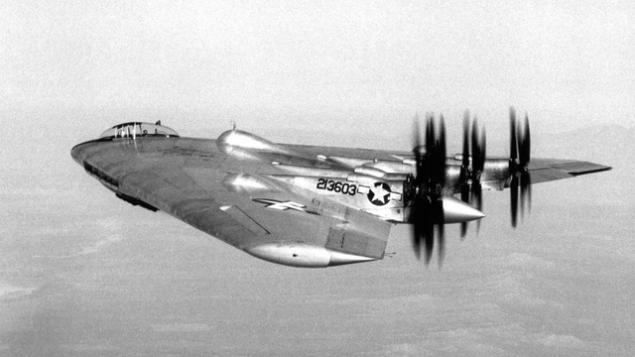
008 McDonnell XF-85 Goblin, American fighter prototype, launch and delivery on the battlefield produced bomber and dropped him like a conventional bomb.
McDonnell XF-85 «Goblin» - an American jet, created as a fighter escort, which would be based on heavy bombers Convair B-36 Peacemaker. The prototype, not commercially produced.
In December 1942, the US Air Force announced a contest called "Project MX-472" - long-distance heavy bomber escort. Within two years, a special commission considered a number of projects, but chose the project "fighter-parasite" that most of the flight was to the bomber inside the case, and if necessary - is discharged outside. The decision was not entirely new - airships such a scheme existed even twenty years before construction Convair B-36 Peacemaker.
In December 1942, the US Air Force announced a contest called "Project MX-472" - long-distance heavy bomber escort. Within two years, a special commission considered a number of projects, but chose the project "fighter-parasite" that most of the flight was to the bomber inside the case, and if necessary - is discharged outside. The decision was not entirely new - airships such a scheme existed even twenty years before construction Convair B-36 Peacemaker.
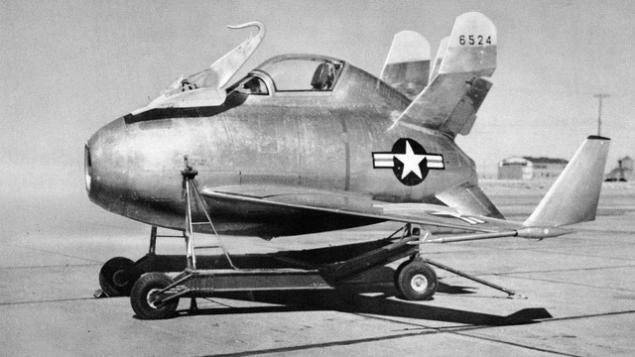
009 Martin XB-51, the American attack. Note unconventional engine layout, one engine in the tail and two sub nose portion (1949).
Among the aircraft the first postwar years were a lot of the original, but even among them unusual structural and layout solutions released XB-51 bomber of the American firm Glenn L. Martin Company. He received the designation of Model 234 Production and absorbed nearly fifteen years of experience of the company for the production of bombers B-10, Maryland, Baltimore and B-26 Marauder.
Striving to meet these requirements in the design of the XB-51 forced the company "Martin" to take such constructive solutions that the aircraft certainly can claim the laurels of one of the most original in the history of aviation. The very first calculations showed that the take-off weight bomber comes close to 36 tons. Payload of 24 500-pound bombs, it was decided to place a long bomb bay and did not make it to the external hardpoints, the disposal of the company had the engine J-47-GE -9, 2360 kg of thrust. To achieve the desired characteristics of the two thrust engines was not enough, and for four it was excessive. This predetermined range of three-engine configuration. When using the three engines in the rear fuselage bomb bay inevitably it moves forward of the wing, which led to a significant run-up center of gravity before and after the bomb release. The shift of center of gravity needed to compensate for the increase in the area of horizontal tail, which led to significant weight costs. Therefore, one motor decided to leave the tail of the fuselage, and the two move forward. But hang them under the wings interfere excessively thin profile. Construction height of the wing in the area of a possible suspension is not guaranteed when using materials of those years to obtain a sufficiently robust design. Thin wing did not allow to place in it and the main landing gear. The final selection of the scheme: two front engine - short pylons in the forward fuselage, one - in the tail section, and the main landing gear - on a "tandem" in front of and behind bomb bay.
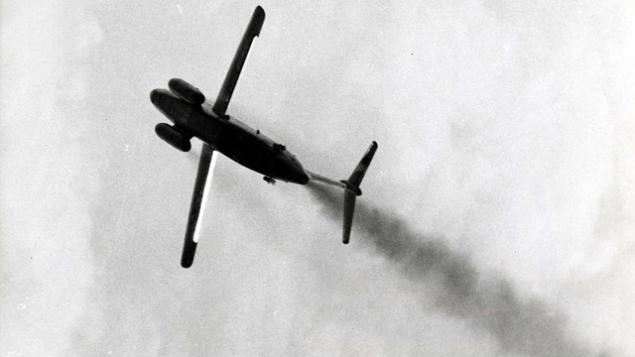
another photo povyrazitelnee.
I forgot to say that many beech. : D
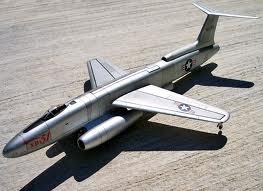
010 Douglas X-3 Stiletto Stiletto, built for research design features necessary for aircraft flying at supersonic speeds (1953 - 1956)
topwar.ru/22894-udivitelny-samolety...a-lippisha.html
www.popmech.ru/article/2345-h-samoletyi/
Source:
In the early 30's the engineer Luigi Steep served in the Italian Air Force proposed the original idea with the fuselage-pipe to increase the efficiency of the screw. This concept has received the name «Ala a turbina». Became interested in the ideas of the Italian Air Ministry ordered Stipe build a flying demonstrator. It was decided to build the aircraft factory of the company Caproni. First flight Stipa, equipped DeHavilland Gipsy III engine 120 hp, held October 7, 1932. Already during the tests the aircraft been crafted - increased elevators and construction of the tail. At the end of testing the aircraft was transferred to the Research Center Montecelio, where he received a registration number MM.187. The aircraft successfully completed these tests, but the results did not satisfy the military, and in 1933 it was dismantled.

002 Vought V-173 "Flying Pancake" American fighter pilot for the US Navy (1942).
In the 1940s, American engineer Charles Zimmerman has created a unique aircraft aerodynamic configuration, which still continues to surprise not only for its unusual appearance, but the flight characteristics. For its unique appearance, he received numerous nicknames, among them such as "Flying parachute", "Flying Pancake" and "Skimmer Zimmerman." Who can say with certainty that the aircraft along with Fi-156 - one of the first devices vertical / short takeoff and landing.

003 Blohm & Voss BV 141, German tactical reconnaissance aircraft differs unusual asymmetry.
In 1937, Reich Air Ministry issued a requirement for a new reconnaissance aircraft. The main requirement was to ensure a good view from the cockpit. Contractor should be firm "Arado" but "Focke-Wulf" and "Blomm + Voss" offered their development. "Focke-Wulf" project proposed twin-engine reconnaissance «Fw 189". "Blomm + Voss" offered more than the original version of the aircraft with an asymmetrical arrangement of the cab and the horizontal tail docked, which improves visibility.
Made of Plexiglas gondola crew resembling a gondola "Focke-Wulf Fw 189", located on the right. On the left is a cylindrical fuselage, which housed the engine «Bramo 323". The fuselage tail ended in that on the first prototypes were symmetrical. In the later samples of the tail unit was shifted to the left to provide a larger field of view arrow.
It seems that the asymmetric design dangerous disbalansiruet plane. However, flight tests confirmed the excellent stability and maneuverability. In addition, increased weight on the right side of the aircraft jet engine torque compensated.

004 Douglas XB-42 Mixmaster, a bomber pilot, designed to bombard at high speed (1944).
In 1943. Douglas staff of the company in Santa Monica proposed conceptual design of the US Air Force medium bomber, pleasing almost optimal combination of classic features and novelty items. It was a plane with two engines placed in the fuselage and rotated by long coaxial shafts screws located in the rear fuselage. Under the engine bay was long and very capacious bomb bay. Cruciform tail served as a good protection for the propeller during takeoff and landing. The crew - three people: two pilots and navigator-bombardier.
It seemed that the idea devoid of serious shortcomings. Even at the stage of preliminary design was well thought through all the technical solutions that were to be put into this project. Equipped with a liquid-cooled in-line engines, "Allison» V-1710-125 capacity to 1725 liters. c., arranged in tandem, the aircraft had to lift up to 3,600 kg of bombs - as much as carrying the first "Flying Fortress" B-17A. Moreover, due to the large and long bomb bay, the new machine could take on board the British 1800 kg and 3600 kg bombs increased power. Maximum speed was estimated at 690-700 km / h - for 1943 is a fantastic figure. This incredible speed for a medium bomber was achieved by maximizing licking the fuselage, refining its aerodynamics and, mainly, through the use of laminar wing. Estimated range exceeded the range of the B-17, the latest series.
It should be noted that the structure of the aircraft was not provided any fundamentally new in the 1943 materials and technologies, the development of which could delay the transfer of a series of machines. The trouble was another - building, debugging and testing of aircraft required too much time, and that was, in the end, this sentence brainchild firm Douglas.

005 British Libellula, tandem wings, a twin-engine layout, created for the carriers (1945).
During the Second World War played an important role the use of naval aviation. The British carrier-based fighter "Hurricane Sea" and "Sifayr", being only slightly modified versions of overland aircraft, had large landing speed. To omit these planes in the hangar deck of aircraft carriers, it was necessary to make folding the wings, leading to an increase in take-off weight. To eliminate these drawbacks English constructor D. Miles developed a project based fighter scheme "tandem". The area of the front wing was 60% of the back. Due to the use of said arrangement intended to reduce the size of the wings, which allowed them to do non-folding, and simultaneously deflected down flaps on the front and back surfaces of the carrier were to provide low speed landing. To test this idea in the aviation company, led by Miles, it was built experimental aircraft M.35.Pervonachalno George Maylzplaniroval plane called Dragonfly, but takkak this name has already been used usamoleta de Havilland DH.90 was decided datproektu name Libellula. The layout of the aircraft M.35 was conceived as suitable for carrier-based fighter; the pilot had a maximum front-mounted, and the engine with a pusher propeller was installed behind the rear wing. As the lift provided two wings, the scope of which could be reduced, it was not necessary in their folding. M.35 aircraft was a single solid wood monoplane with a pusher propeller. The front bearing surface elevators are arranged at the rear - ailerons. Moreover, both surfaces have landing flaps. Vertical tail was carried out in the form of washers on the end of the wing. An interesting feature of the aircraft was a highly swept main wing endings. Swept wing helped to improve directional stability and damping longitudinal vibrations, allowing to increase the vertical stabilizer arm action. A three-wheeled chassis with nose wheel was provided with an additional rear wheel, which prevents the propeller from damage during landing with a large angle of attack. Making M.35 was entrusted company Phillips & Powis Aircraft Limited. The first prototype aircraft M.35 (under the temporary registration number U-0235) was made and raised in the air for six weeks (the first flight took place on May 1, 1942) .Real M.35 was not a real fighter, but rather a technology demonstrator and He did not even established any weapons. The tests revealed a significant aircraft longitudinal instability. Subsequently, by changing the alignment of several managed to improve the stability of the aircraft., But considering all the disadvantages, as well as taking into account the fact that the fighters who are in the time in service of the British Navy surpassed all indicators M.35 contract for production and has not been signed .
Despite the failure with the aircraft M.35, Miles did not leave his ideas and in 1942 proposed a draft twin-engine bomber near M.39 configuration. In the summer of 1943 it was built the plane M-39B, which is five times smaller prototype bomber. Unlike M.35 This aircraft had a smaller area of the front horizontal surface. Under the main wing was installed two engines, rotating pulling propellers. The machine took off July 22, 1943. Flying aircraft M-39B showed quite satisfactory stability and controllability of the aircraft in a wide range of CG. Like its predecessor, the M-39B aircraft had flaps on both wings with which it was possible to balance the plane at any position knob. The test aircraft were accompanied by a number of embarrassing setbacks. In one of the flight the pilot forgot to release the landing gear. Soon, during taxiing aircraft heavy small M-39B was overturned jet from the propeller and received significant damage. This test was completed on the project and the aircraft was given up.

006 North American XF-82. In fact, it is "glued" together two P-51 Mustang, and we've got a fighter escort to long range (1946).
North American F-82 "Twin Mustang" (eng. North American F-82 Twin Mustang) - US long-range fighter double. Known as the last piston fighter of the US Air Force.
"Twin Mustang" was originally intended to escort strategic bombers B-29s during raids on Japan. In the course of these long-range raid fighter pilots were subjected to a heavy load, so the new fighter was to be a two-seater. North American company began designing this aircraft under the designation NA-120 in late 1943. It made an unusual design solution: the aircraft consisted of two elongated fuselage of fighter P-51H, connected by a wing and tailplane.
XP-82 prototype first flew on July 6, 1945 - too late to take part in World War II. This led to the fact that the initial US Air Force order for 500 aircraft was reduced by the end of 1945 to 270 aircraft. "Twin Mustangs" were replaced by P-61 "Black Uidou" as the main night fighter. They also brought to the task for which you were created - escort strategic bombers, the B-29, B-50 and B-36.
In February 1947, the P-82B (serial number 44-65168, "Betty Jo") made a nonstop flight from Honolulu to New York (about 5,000 miles), which took 14 hours and 32 minutes. Robert Tucker piloted aircraft and John Ard. This distance record for a piston fighter is not beaten yet. "Betty Jo" is the exposition of the National Museum of the US Air Force.

007 Northrop XB-35 heavy bomber pilot-wing developed for the US Army immediately after World War II.
In September 1941, the company «Northrop» began designing the giant aircraft - "flying wing" with four radial engines air cooling «Pratt & Whitney» R-4360-17 capacity of 3000 hp designed for the delivery of 10,000 pounds (4,540 kg) of bombs on a fantastic range of 5,500 km. Design Ferry range this combat load was 12,400 km. Before the engineering team of John Northrop fell a number of engineering, layout and aerodynamic problems that the process of research and development was delayed until the end of 1945 and the first prototype XB-35 Northrop made its first flight only June 25, 1946.
The plane hit the giant size and power - wingspan Northrop XB-35 was 52, 5 m. It was aerodynamically pure flying wing with a thick symmetrical profile. The layout of the car was quite dense and highly efficient - the benefits of the chosen scheme implemented to the maximum. Structurally, the body-wing Northrop XB-35 consisted of the central section (center section) and two consoles. The wear of the central section of the aircraft was equipped with a spacious and comfortable cabin sealed for six crew members. The commander of the crew, he also left the pilot, was placed on a hill and has all-round visibility thanks to the large drop-shaped lamp offset from the plane of symmetry of the aircraft to the left. The second pilot was located to the right of and below the first. Before him there was a transparent panel windshield, let us a good overview forward and down.
The navigator-bombardier to the right of the second pilot. Over his workplace had Astrodome. Behind the commander of the crew sat gunner operator barbettes wing machine guns. His main working tool was a sighting periscope whose optical head out on top and on the bottom surface of the body - the wing. In the left rear of the cab radio operator located on the right - the flight engineer with a big dash of control engines. Between jobs radio operator and engineer I had a door leading to the cabin rear gunner in charge of the top, bottom and rear of the turret. The walls of the corridor leading to the back of the cabin, there were passages in the engine compartment for inspection and repair of engines in flight, equipped with air locks. In the case of flight sverhdlitelnyh in the center section there is adequate space to accommodate suspended beds for relief crew.

008 McDonnell XF-85 Goblin, American fighter prototype, launch and delivery on the battlefield produced bomber and dropped him like a conventional bomb.
McDonnell XF-85 «Goblin» - an American jet, created as a fighter escort, which would be based on heavy bombers Convair B-36 Peacemaker. The prototype, not commercially produced.
In December 1942, the US Air Force announced a contest called "Project MX-472" - long-distance heavy bomber escort. Within two years, a special commission considered a number of projects, but chose the project "fighter-parasite" that most of the flight was to the bomber inside the case, and if necessary - is discharged outside. The decision was not entirely new - airships such a scheme existed even twenty years before construction Convair B-36 Peacemaker.
In December 1942, the US Air Force announced a contest called "Project MX-472" - long-distance heavy bomber escort. Within two years, a special commission considered a number of projects, but chose the project "fighter-parasite" that most of the flight was to the bomber inside the case, and if necessary - is discharged outside. The decision was not entirely new - airships such a scheme existed even twenty years before construction Convair B-36 Peacemaker.

009 Martin XB-51, the American attack. Note unconventional engine layout, one engine in the tail and two sub nose portion (1949).
Among the aircraft the first postwar years were a lot of the original, but even among them unusual structural and layout solutions released XB-51 bomber of the American firm Glenn L. Martin Company. He received the designation of Model 234 Production and absorbed nearly fifteen years of experience of the company for the production of bombers B-10, Maryland, Baltimore and B-26 Marauder.
Striving to meet these requirements in the design of the XB-51 forced the company "Martin" to take such constructive solutions that the aircraft certainly can claim the laurels of one of the most original in the history of aviation. The very first calculations showed that the take-off weight bomber comes close to 36 tons. Payload of 24 500-pound bombs, it was decided to place a long bomb bay and did not make it to the external hardpoints, the disposal of the company had the engine J-47-GE -9, 2360 kg of thrust. To achieve the desired characteristics of the two thrust engines was not enough, and for four it was excessive. This predetermined range of three-engine configuration. When using the three engines in the rear fuselage bomb bay inevitably it moves forward of the wing, which led to a significant run-up center of gravity before and after the bomb release. The shift of center of gravity needed to compensate for the increase in the area of horizontal tail, which led to significant weight costs. Therefore, one motor decided to leave the tail of the fuselage, and the two move forward. But hang them under the wings interfere excessively thin profile. Construction height of the wing in the area of a possible suspension is not guaranteed when using materials of those years to obtain a sufficiently robust design. Thin wing did not allow to place in it and the main landing gear. The final selection of the scheme: two front engine - short pylons in the forward fuselage, one - in the tail section, and the main landing gear - on a "tandem" in front of and behind bomb bay.

another photo povyrazitelnee.
I forgot to say that many beech. : D

010 Douglas X-3 Stiletto Stiletto, built for research design features necessary for aircraft flying at supersonic speeds (1953 - 1956)
topwar.ru/22894-udivitelny-samolety...a-lippisha.html
www.popmech.ru/article/2345-h-samoletyi/
Source:
Tags
See also
Little-known Soviet aircraft
Unusual maps
Weapon of Victory
Famous engines: 10 steps to perfection
Top bombers of the twentieth century (10 pics + text)
The plane with a nuclear reactor
With 37 "Berkut" (5 pictures, little letters)
Chronicles of sabotage units
When a few of the fuselage: two-beam planes
Excitement around the project C-37

















